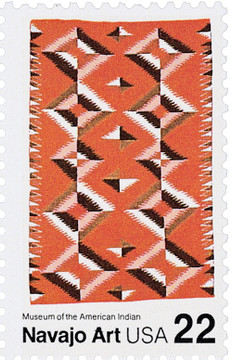
U.S. #2235-38
1986 22¢ Navajo Blankets
American Folk Art Series
- Sixth set in American Folk Art Series
- Pictures Navajo blankets from US museums
Stamp Category: Commemorative
Series: American Folk Art
Value: 22¢, first-class rate
First Day of Issue: September 4, 1986
First Day City: Window Rock, Arizona
Quantity Issued: 240,525,000
Printed by: Bureau of Engraving and Printing
Printing Method: Lithographed and Engraved
Format: Panes of 50 in sheets of 200
Perforations: 11
Why the stamps were issued: To honor the traditional art of Navajo blanket-weaving.
About the stamp designs: Derry Noyes designed these stamps with illustrations based on actual Navajo blankets. Three of blankets are housed in the Museum of the American Indian in New York City and the fourth is owned by the Lowe Art Museum.
First Day City: These stamps were issued to coincide with the annual Navajo Nation Fair held at Window Rock, Arizona, which lies in the heart of the Navajo reservation.
Unusual fact about these stamps: Error varieties of these stamps have been found with the black engraved intaglio printing omitted.
About the American Folk Art Series: The USPS created the Folk Art Series in 1977 to honor important and lesser-known items in American art and culture. Folk Art is loosely defined as the art of the everyday, rooted in traditions that come from community and culture and expressing cultural identity by conveying shared community values and aesthetics. The series lasted nearly 20 years and featured folk art including Pueblo pottery, quilts, Pennsylvania toleware, Pacific Northwest Indian Masks, duck decoys, Navajo Blankets, wood-carved figures, lacemaking, carousel animals, Indian headdresses, and carousel horses. Click here for more about the series.
History the stamps represent: Blanket weaving has been an important part of Navajo culture for centuries. To early tribes, each blanket was believed to possess spiritual characteristics and reflect the owner’s identity.
According to tribal lore, the holy Spider Woman gave the Navajo woman her weaving talents. Young girls prepare to carry on her craft by rubbing a spider’s web on their hands and arms.











